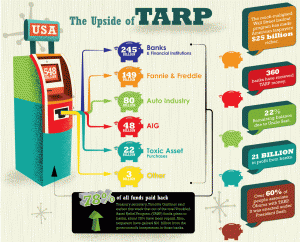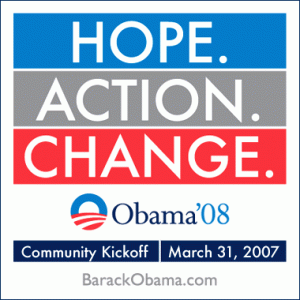 Historic moments define presidencies. For President Obama, that moment came in the form of a nation teetering on the brink of depression.
Historic moments define presidencies. For President Obama, that moment came in the form of a nation teetering on the brink of depression.
The President responded to the crisis by (while still Senator) supporting TARP and then, as President, spearheading a massive stimulus package.
This stimulus was very much unlike the federal “New Deal” spending that occurred under FDR during the depression, which included a primary focus on creating as many jobs as possible. Indeed, there are still many monuments to the WPA and related programs standing today (most notably, Hoover Dam, a primary energy source for the Southwest United States).
When you look at a breakdown on how American Recovery Act federal stimulus dollars were spent, you find that a big portion went to tax cuts, while the rest was spread scattershot over many programs. Much of these funds came in the form of aid to States, which supported essential programs (like Medicaid), but only long enough for States to put off most painful budget cuts until this year.
 Today we struggle with a 9.2% unemployment rate, and a continuation of tax policies that redistribute wealth to the very top. Last December, President Obama arrived at a “compromise” with congressional Republicans to extend the Bush tax code designed to accelerate redistribution of wealth to those who are already very wealthy. Indeed, Reaganomics followed by W’-nomics have had their intended effect: over the past quarter century four-fifths of income gains have gone to the top 1% of individuals, while middle class wages haven’t kept up with inflation. Contrary to GOP rhetoric, trickle-down economics has defied gravity.
Today we struggle with a 9.2% unemployment rate, and a continuation of tax policies that redistribute wealth to the very top. Last December, President Obama arrived at a “compromise” with congressional Republicans to extend the Bush tax code designed to accelerate redistribution of wealth to those who are already very wealthy. Indeed, Reaganomics followed by W’-nomics have had their intended effect: over the past quarter century four-fifths of income gains have gone to the top 1% of individuals, while middle class wages haven’t kept up with inflation. Contrary to GOP rhetoric, trickle-down economics has defied gravity.
Many progressives, me included, were hoping last December the President would take the fight to an opposition that would allow all tax cuts expire in the name of keeping income tax breaks for the wealthiest 2% of Americans. Had no compromise been reached, we would’ve returned to President Clinton’s more progressive tax code, which may well have proven a best case scenario with the added benefit of eradicating much of our deficit problem. But Obama didn’t take this approach. Rather, the debate was between keeping 98% of Bush’s tax code versus keeping 100% of Bush’s tax code. Hence, the GOP would’ve “lost” this showdown last December by only getting 98% of what they wanted versus 100%. Seems to me, they would’ve won either way. They got their 100% regardless.
Now our national treasury is enduring diminished returns (by design) as we enter into the current showdown over the debt ceiling. The Republicans have again drawn lines in the sand, including an insistence on no tax increases. (For Republicans, closing loopholes also translates into tax a increase; this is why I paid a larger percentage of my middle-class income to Uncle Sam than General Electric or Exxon last year.) In exchange for GOP cooperation to lift the debt ceiling, the President appears ready to offer trillions in cuts to entitlement programs that middle-class folks have paid into their entire lives in order to have a decent retirement and decent healthcare. The GOP is holding their ground, and who could blame them? If last December’s “compromise” is any indication, they should feel empowered in assuming the President will capitulate.
 Regardless of Obama’s desires, the outcomes of this presidency has been to prolong Bush’s regressive tax policies that he had the power to end, TARP that kept banks healthy (and whose CEO’s have avoided the perp walks they deserve) but didn’t translate into loans to American small businesses, and a stimulus that prevented a depression but didn’t translate into robust job creation. Indeed, we now can look back in hindsight and realize that stimulus was primarily a hodgepodge of temporal fixes.
Regardless of Obama’s desires, the outcomes of this presidency has been to prolong Bush’s regressive tax policies that he had the power to end, TARP that kept banks healthy (and whose CEO’s have avoided the perp walks they deserve) but didn’t translate into loans to American small businesses, and a stimulus that prevented a depression but didn’t translate into robust job creation. Indeed, we now can look back in hindsight and realize that stimulus was primarily a hodgepodge of temporal fixes.
The tragedy here is that a Democratic President and a Democratic Congress could have actually supported programs that had a transformative effect on those areas of most acute need, including (1) creating a 21st century workforce; (2) remaking our nation’s infrastructure; and (3) positioning America to lead the word in new energy.
So now we are left with a bunch of “what if’s” ….
What if the president invested heavily in re-skilling the American worker? For about $10 billion, the US could’ve invested in a vocational equivalent to the GI Bill to give American workers the training needed to fill what is estimated to be five million chronically unfilled jobs that exist due to skills gaps. (This type of training could’ve also been tied to unemployment compensation extensions.) Filling these existing jobs alone would bring American unemployment rates below 7%, while helping major American industries expand. By the way, America’s leading corporations in sectors like IT, healthcare and advanced manufacturing would’ve been the biggest cheerleaders for such policies, and probably would’ve brought along much of the business community in support.
 What if the president invested heavily in rebuilding the nation’s chronically crumbling infrastructure? Only 5% of stimulus funding went to infrastructure, when it should’ve been greater than 50%. Stimulus should’ve sped up the process to fund thousands of projects in queue to fix crumbling bridges and sewer systems, expand congested highways, bolster flood prevention, and so on. What if Obama did like Ike, who oversaw the construction of the modern highway system with the coming of the age of the automobile, and declared the coming of the age of advanced transit linking all of America by high speed rail and intra-linking communities by spokes that feed of that rail (street cars, etc)?
What if the president invested heavily in rebuilding the nation’s chronically crumbling infrastructure? Only 5% of stimulus funding went to infrastructure, when it should’ve been greater than 50%. Stimulus should’ve sped up the process to fund thousands of projects in queue to fix crumbling bridges and sewer systems, expand congested highways, bolster flood prevention, and so on. What if Obama did like Ike, who oversaw the construction of the modern highway system with the coming of the age of the automobile, and declared the coming of the age of advanced transit linking all of America by high speed rail and intra-linking communities by spokes that feed of that rail (street cars, etc)?
I suspect a Democratic controlled congress would’ve supported this, and even some Republicans might have felt uncomfortable coming out against projects that repair local infrastructure while creating local jobs. GOP Governors would’ve been among the greatest advocates. Former CA Governor Schwarzenegger called the stimulus infrastructure spending a disappointment against an estimated $250 billion needed annually to handle infrastructure needs, and touted estimates that “For every billion dollars that you spend on infrastructure, you create 18,000 to 25,000 jobs.” Let’s say President Obama devoted half the stimulus pot to infrastructure, with an immediate focus on “shovel-ready” projects in queue (0-3 year out) and a longer term focus on high speed rail (2-5 years out). We’d be talking aproximately 8 million well paying jobs, and an unemployment rate that, coupled with workforce investment, would be spiraling downward to below 5%. Five years of this kind of spending would have helped give America the stimulus it needed to regain its economic footing once the stimulus funds expired. Like workforce investment, infrastructure investment would’ve garnered significant pockets of private sector support, and conversely, some of votes of the GOP that lives in corporate pockets.
Finally, what if the President had combined his investment in transportation alternatives with accelerating our move to energy independence and toward leading the world in new energy technology? Some stimulus funds went to such ends, but investment on the scale of a New Deal could’ve made wind a primary energy supplier for the East and West states, plains states (from Kansas to Texas following the wind corridor) and cities on the Great Lakes and solar power a primary source for our Western and Southwestern states. These would’ve been 21st century equivalents to Hoover Dam. These investments, coupled with remaking antiquated power grids, would’ve created lots of jobs, short-term and long-term, while making America a global leader in new energy. As an added benefit, it would also shift geopolitical power away from oppressive regimes that feed on oil money, and end our days spending trillions on wars fought over foreign oil.
 Obama funded some of these kinds of programs modestly, which will do some good. But he didn’t rise to the historic moment, and historic moments only come every few decades. If the same amount he had spent on stimulus were spent on investing in American workers and American infrastructure and American energy independence, our economy would be roaring right now, with short term stimulus providing a massive down payment towards remaking our workforce and economy for the long term.
Obama funded some of these kinds of programs modestly, which will do some good. But he didn’t rise to the historic moment, and historic moments only come every few decades. If the same amount he had spent on stimulus were spent on investing in American workers and American infrastructure and American energy independence, our economy would be roaring right now, with short term stimulus providing a massive down payment towards remaking our workforce and economy for the long term.
But instead, we find ourselves in a present defined by an unemployment rate that is growing again, and a debate over the debt ceiling that has given Republicans who deserve absolutely no credibility the upper-hand in defining a “compromise” that will undermine middle class America and our most vulnerable citizens.
President Obama is veering towards a one-term presidency whose crowning economic achievement is that he staved off a depression. That is commendable and shouldn’t be dismissed. But we could’ve staved off collapse in a manner that also positioned America for long-term prosperity and as a leader in the New Economy. To date, President Obama’s competent (but not transformative) leadership, met by Republican dereliction of leadership, has created conditions where our nation has become fixated on the debt ceiling, as opposed to the very travesty that we are debating whether to pay off debt financed by economic competitors who we should be eating for lunch.
 The president of “hope and change” could’ve also assembled a strong post-partisan coalition of leading sector CEO’s, a few GOP Governors and statesmen, and his progressive base in a partnership that certainly would’ve undone the Red State versus Blue State divide that US Senate-candidate Obama railed against during his forceful speech at the 2004 Democratic convention.
The president of “hope and change” could’ve also assembled a strong post-partisan coalition of leading sector CEO’s, a few GOP Governors and statesmen, and his progressive base in a partnership that certainly would’ve undone the Red State versus Blue State divide that US Senate-candidate Obama railed against during his forceful speech at the 2004 Democratic convention.
President Obama, the debate can still be defined by major investment in the American worker, American infrastructure, and our energy future. But it is you and you alone who can pivot us away from current dialogue centered on cutting entitlements and preserving tax breaks for American billionaires and millionaires. Like many progressives, I clamor for a compelling new narrative that shows us a way to an alternative vision for America that invests in the American worker, American infrastructure and American energy independence as a path to restoring our greatness. You could own the moment . . . if only you’d rise to it. Our nation would rise with it.









Leave a Reply